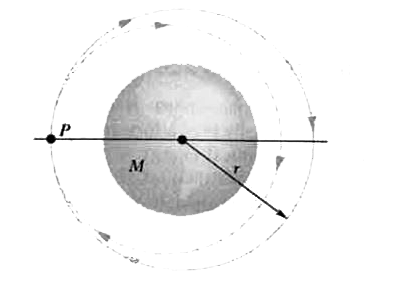A spaceship of mass m=4.50×103kg is in a circular Earth orbit of radiusr=8.00×106m and period T0=118.6 min=7.119×103 s when a thruster is fired in the forward direction to decrease the speed to 96.0% of the original speed.What is the period T of the resulting elliptical orbit ?
(1) An ellipical orbit period is related to the semimajor exis a by Kepler.s third law,written as Eq. 13.36 (T2=4π2r3/GM) but withareplacing r.(2) The semima-jor axis is related to the total mechanical energy E of the ship by Eq. 13-44 (E = -GMm/2a), in which Earth.s

mass is M=5.98×1024kg. (3) The potential energy of the ship at radius r from Earth.s center is given by Eq. 13-23 (U = -GMm/r).
Calculations : Looking over the Key Ideas, we see that we need to calculated the total energy E to find the semimajor axis a, so that we can then determine the period of the elliptical orbit. Let.s start with the kinetic energy, calculating it just after the thruster is fired. The speed v just then is 96% of the circumference of the initial circular orbit tot he initial period of the orbit. Thus, just after the thrusteris fired, the kineticenergy is
K=12mv2=12m(0.96v0)2=12m(0.96)2(2πrT0)2
=12(4.50×103kg)(0.96)1(2π(8.00×106m)7.119×103s)2
=1.0338×1011J.
Just after the thruster is fired,the ship is still at orbital radius r, and thus its gravitational protential energy is
U=−GMmr
=−(6.67×10−11N.m2/kg2)(5.98×1024kg)(4.50×103kg)8.00×106m
=−2.2436×1011J.
We can now find the semimojar axis by rearranging Eq. 13.44, substituting a for , and then substitutingin our energy results:
a=−GMm2E=−GMm2(K+U)
=−(6.67×10−11N.m2/kg2)(5.98×1024kg)(4.50×103kg)2(1.0338×1011J−2.2436×1011J)
=7.418×106m.
Now, one more step to go. We substitute a for r in Eq. 13.36 and then solve for the period T,substituting our result for a:
T=(4π2a3GM)1/2
=⎛⎝4π2(7.418×106m)3(6.67×10−11N.m2/kg2)(5.98×1024kg)⎞⎠1/2
=6.356×103s=106min.
This is the period of the elliptical orbit that the ship takes after the thrusteris fired. It is less than the period T0 for the circular orbti for two reasons. (1) The orbital path length is now less. (2) The elliptical path takes the ship closer to Earth everywhere except at the point of firing. The resulting decrease in gravitational potential energy increases the kinetic energy and thus also the speed of the ship.
Topper's Solved these Questions
- BOOK - RESNICK AND HALLIDAYCHAPTER - GRAVITATIONEXERCISE - CHECKPOINT5videos
GRAVITATION
- BOOK - RESNICK AND HALLIDAYCHAPTER - GRAVITATIONEXERCISE - PROBLEMS63videos
GRAVITATION
- BOOK - RESNICK AND HALLIDAYCHAPTER - GEOMETRICAL OPTICS : REFRACTIONEXERCISE - Practice questions(Integers)4videos
GEOMETRICAL OPTICS : REFRACTION
- BOOK - RESNICK AND HALLIDAYCHAPTER - HEAT-MEASUREMENT AND TRANSFEREXERCISE - PRACTICE QUESTIONS( INTEGER TYPE)5videos
HEAT-MEASUREMENT AND TRANSFER
Similar Questions
A satellite of mass 200 kg revolves around of mass 5×1030 kg In a circular orbit of radius 6.6×106 m . Binding energy of the satellite is
View SolutionA 30 kg satellite has a circular orbit with a period of 2.0 h and a radius of 9.0×106 m around a planet of unknown mass. If the magnitude of the gravitational acceleration on the surface of the planet is 6.0m/s2. what is the radius of the planet?
View Solution
Knowledge Check
- Question 1 - Select One
A proton of mass 1.6×10−27kg goes round in a circular orbit of radius 0.10 m under a centripetal force of 4×10−13N. then the frequency of revolution of the proton is about
A0.08×108 cycles per secB4×108 cycles per secC8×108 cycles per secD12×108 cycles per sec - Question 2 - Select One
A satellite of mass 200 kg revolves around of mass 5×1030 kg In a circular orbit of radius 6.6×106 m . Binding energy of the satellite is
A5×1015JB−5×1015 JC1016JD−1016J - Question 3 - Select One
The electron in a hydrogen atom moves in a circular orbit of radius 5×10−11m with a speed of 0.67×108m/s Then
Athe frequency of revolutions of the electron is 6×10−15rev/sBthe electron carries −1.6×10(−19)C around the loopCthe current in the orbit is 0.96mADthe current flow in the opposite direction to the direction of motion of electron
The electron in a hydrogen atom moves in circular orbit of radius 5×10−11m with a speed of 0.6π×106m/s then
View SolutionWhile investigating the planet Norc in another solar system, we find that the radius of Norc is 9.54×106m and that the period of a satellite put in circular orbit of radius 1.476×107m is 8.09×103s. Determine (a) the mass of Norc, (b) The average, mass density of Norc, (c) the value of the gravitational field on the surface of Norc. (d) If the period of Norc's rotation about its axis is 1.04×104s, what will be the reading on a spring scale (calibrated on earth) supporting a 1.0kg object at Norc's equator ?
View SolutionIf a planet of mass m is revolving around the sun in a circular orbit of radius r with time period, T then mass of the sun is
View SolutionAn electron has a mass of 9.1×10−31kg. It revolves round the nucleus in a circular orbit of radius 0.529×10−10 metre at a speed of 2.2×106m/s. The magnitude of its linear momentum in this motion is
View SolutionThe electron in a hydrogen atom moves in circular orbit of radius 5×10−11m with a speed of 0.6π×106m/s then
View Solution

